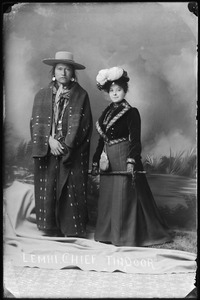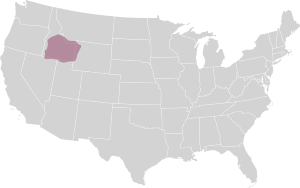Northern Shoshone facts for kids

Tindoor, chief of the Lemhi Shoshone and his wife, Idaho, ca. 1897, photograph by Benedicte Wrensted
|
|
| Regions with significant populations | |
|---|---|
| Languages | |
| Shoshone, English | |
| Religion | |
| Native American Church, Sun Dance, traditional tribal religion, Christianity, Ghost Dance |
|
| Related ethnic groups | |
| other Shoshone people, Bannock |
The Northern Shoshone are a group of Shoshone people. They traditionally lived in parts of southern Idaho, Wyoming, and Utah. Their homeland includes the Snake River Plain in Idaho and the northeastern part of the Great Basin.
These people have close cultural ties with the Bannock people. They are part of the larger group known as Indigenous people of the Great Basin.
Contents
Their Language
The Northern Shoshone speak a special form of the Shoshoni language. This language is part of the Numic languages family. It is also connected to the even larger Uto-Aztecan language family.
Today, the Northern Shoshone language is mainly spoken on two reservations. These are the Fort Hall Indian Reservation in Idaho and the Wind River Indian Reservation in Wyoming.
Different Groups (Bands)
The Shoshone people lived in smaller groups called "bands." These bands were often named after their homelands. They were also named after the main foods they ate.
Here are some of the Northern Shoshone bands:
Mountain Shoshone Bands
- Agaideka (also called Salmon Eaters): These people lived along the Snake River and in the Lemhi River Valley in Idaho. They were known for fishing for salmon. After getting horses, they also hunted buffalo.
- Tukudeka (also called Sheep Eaters): This band lived in the mountains of Idaho and Wyoming. They hunted mountain sheep. Some Tukudeka joined the Eastern Shoshone on the Wind River Reservation. Others became part of the Lemhi Shoshone.
Northwestern Shoshone Bands
- Kammitikka (Jack Rabbit Eaters): They lived near Bannock Creek in Idaho. Their lands stretched from the Raft River to the Portneuf River. Many of them later moved to the Fort Hall Indian Reservation.
- Painkwitikka (Fish Eaters): These people lived along the Bear River near the Idaho and Utah border. They were known for eating fish.
- Cache Valley Shoshone: This group lived in Cache Valley in Idaho and Utah. In 1863, many of them were lost in a sad event called the Bear River Massacre. The survivors later settled on the Fort Hall Reservation.
- Weber Utes: This band lived along the Weber River in Utah. They spoke Shoshone, but because they married people from the Ute tribe, they were often called "Weber Utes."
Fort Hall Shoshone Bands
- Boho'inee (Sage Grass People): This was a mixed group of Shoshone and Bannock. They lived in southeastern Idaho on the Snake River Plain. They often spent winters near the trading post called Fort Hall. They are now known as the Fort Hall Shoshone.
Western Bands of Northern Shoshone
- Yahandeka (Groundhog Eaters): These were mixed groups of Northern Shoshone and Northern Paiute.
- Boise Shoshone: They hunted along the Boise River in Idaho. Their leader, Peiem, was important in early meetings with fur traders. Many later moved to the Fort Hall Reservation.
- Bruneau Shoshone: They lived in southwestern Idaho along the Bruneau River. After gold was found, settlers moved in. Some of them later moved to the Duck Valley Indian Reservation.
- Weiser Shoshone: They lived along the Weiser River in Idaho. Some of this group also moved to the Fort Hall and Duck Valley Reservations.
Today: Tribes and Reservations
Today, Northern Shoshone people are part of several officially recognized tribes. These tribes are located in Idaho and Utah.
- Duck Valley Indian Reservation: This reservation is in Idaho. It is home to the Western Shoshone-Northern Paiute Tribe.
- Shoshone-Bannock Tribes of the Fort Hall Reservation of Idaho: This large reservation is in Idaho. It is home to the Lemhi Shoshone and the Bannock people.
- Northwestern Band of the Shoshone Nation: This tribe represents many of the Northwestern Shoshone bands.


